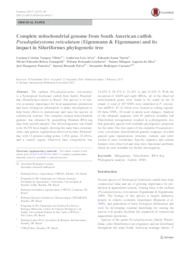Complete mitochondrial genome from South American catfish Pseudoplatystoma reticulatum (Eigenmann & Eigenmann) and its impact in Siluriformes phylogenetic tree.
Complete mitochondrial genome from South American catfish Pseudoplatystoma reticulatum (Eigenmann & Eigenmann) and its impact in Siluriformes phylogenetic tree.
Autoria: VILLELA, L. C. V.; ALVES, A. L.; VARELA, E. S.; YAMAGISHI, M. E. B.; GIACHETTO, P. F.; SILVA, N. M. A. da; PONZETTO, J. M.; PAIVA, S. R.; CAETANO, A. R.
Resumo: The cachara (Pseudoplatystoma reticulatum) is a Neotropical freshwater catfish from family Pimelodidae (Siluriformes) native to Brazil. The species is of relative economic importance for local aquaculture production and basic biological information is under development to help boost efforts to domesticate and raise the species in commercial systems. The complete cachara mitochondrial genome was obtained by assembling Illumina RNA-seq data from pooled samples. The full mitogenome was found to be 16,576 bp in length, showing the same basic structure, order, and genetic organization observed in other Pimelodidae, with 13 protein-coding genes, 2 rNA genes, 22 trNAs, and a control region. Observed base composition was 24.63% T, 28.47% C, 31.45% A, and 15.44% G. With the exception of NAD6 and eight tRNAs, all of the observed mitochondrial genes were found to be coded on the H strand. A total of 107 SNPs were identified in P. reticulatum mtDNA, 67 of which were located in coding regions. Of these SNPs, 10 result in amino acid changes. Analysis of the obtained sequence with 94 publicly available full Siluriformes mitogenomes resulted in a phylogenetic tree that generally agreed with available phylogenetic proposals for the order. The first report of the complete Pseudoplatystoma reticulatum mitochondrial genome sequence revealed general gene organization, structure, content, and order similar to most vertebrates. Specific sequence and content features were observed and may have functional attributes which are now available for further investigation.
Ano de publicação: 2017
Tipo de publicação: Artigo de periódico
Observações
1 - Por padrão são exibidas publicações dos últimos 20 anos. Para encontrar publicações mais antigas, configure o filtro ano de publicação, colocando o ano a partir do qual você deseja encontrar publicações. O filtro está na coluna da esquerda na busca acima.
2 - Para ler algumas publicações da Embrapa (apenas as que estão em formato ePub), é necessário ter, no celular ou computador, um desses softwares gratuitos. Sistemas Android: Google Play Livros; IOS: iBooks; Windows e Linux: software Calibre.
Acesse outras publicações
Acesse a Base de Dados da Pesquisa Agropecuária (BDPA) para consultar o acervo completo das bibliotecas da Embrapa.

